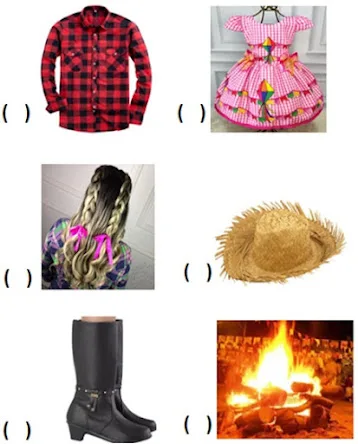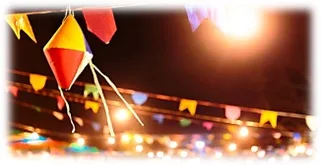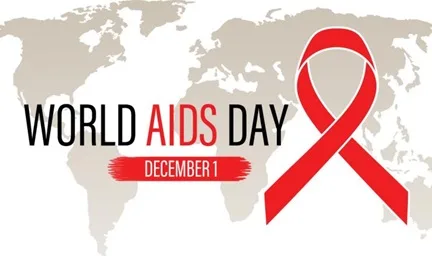Apresentamos uma excelente Atividade de Inglês sobre as Festas Juninas para os estudantes do 6°, 7°, 8° e 9° ano. Celebradas em todo o Brasil, as Festas Juninas são uma tradição cultural muito importante para o nosso país. Neste publicação, vamos explorar como é possível abordar esse tema em aulas de Inglês, de forma lúdica e formativa.
Download e planejamento do conteúdo disponíveis no final da publicação
GET TO KNOW THE TYPICAL BRAZILIAN “JUNE PARTY”
In June and July, Brazil celebrates the June Party, in portuguese “Festa Junina”. It is not as popular as carnival, but it is as celebrated and expected by Brazilians. Through all the streets you can see the parties going on. Bonfires, music, food, dancing and traditional clothes everywhere.
“Quadrilha” is the traditional dance of the party. When it arrived here the Brazilian people gave their own identity to this dance. The typical “Quadrilha” dance started in the salons of the court of Paris (Quadrille) and came to Brazil after the colonization, where the Brazilians gave their own identity to the dance.
The “Quadrilha” goes through several funny phases until the main couple, dressed as bride and groom, get married. The wedding is one of the most anticipated moments of the party and has priest, delegate and godparents present. The moment is full of humor and makes jokes with traditional weddings. The groom is practically forced to marry under pressure from the bride’s father and despite some attempts, he can not escape marriage.
The clothes used in the dances are very traditional. Women wear flowered dresses with ruffles, boots, straw hats and braids in their hair. The men wear plaid shirts, jeans with sewn flaps, boots, and a straw hat. These are the most common clothes worn in Festas Juninas, inspired by the rural style of those who live in the countryside. However it varies a lot according to the region of Brazil.
https://www.falabrasilschool.com/brazilian-june-party
Atividades
1. Apesar que as festas juninas não sejam tão populares como o carnaval, o texto descreve essa comparação em: but it is as celebrated and expected by Brazilians.
O que isso significa?
2. Na frase: Through all the streets you can see the parties going on.
Por todas as ruas você pode ver:
3. Segundo o texto, o que é uma “Quadrilha”?
4. “Quadrilha” pareceu nos salões da corte de Paris e veio para o Brasil em um determinado período da história. O texto pontua isso em:
… after the colonization.
Quando isso aconteceu?
5. O casamento é um dos momentos mais esperados da festa e tem a participação de: priest, delegate and godparents.
Traduza:
Priest: _____________________________________________
Delegate: __________________________________________
Godparents: ________________________________________
6. As roupas usadas nas danças são muito tradicionais. Escreva em inglês o que as mulheres vestem.
7. Encontre no texto a menção em inglês de: Os homens usam camisa xadrez, jeans com aba costurada, botas e chapéu de palha.
8. O noivo é praticamente obrigado a casar por pressão do pai da noiva e, apesar de algumas tentativas, não consegue escapar do casamento.
Encontre no texto as expressões.

9. Leia o trecho e responda:
These are the most common clothes worn in Festas Juninas, inspired by the rural style of those who live in the countryside.
De onde vem a inspiração nas roupas utilizadas nas festas juninas?
10. Associe as colunas.
(A) Bonfires
(B) Flowered dresses
(C) Straw hats
(D) Boots
(E) Braids
(F) Plaid shirts

+ Conteúdos de Inglês para os Anos Finais
Confira nossa página repleta de conteúdos semelhantes, especialmente desenvolvidos para esse público escolar. Materiais pedagógicos de alta qualidade, cuidadosamente preparados pelos produtores do Tudo Sala de Aula. Clique agora e escolha o tema da aula!
Planejamento para o professor
Objeto do conhecimento: Festas Juninas.
Objetivo da Aula: Desenvolver o vocabulário e a compreensão cultural em inglês, explorando tradições e símbolos das festas juninas brasileiras.
Por favor, não compartilhe o PDF!
Reiteramos que todo o conteúdo do site Tudo Sala de Aula é original, produzido por equipe própria. Portanto, este material, assim como os demais, não pode ser publicado em sites pessoais ou copiado para a criação de apostilas para venda. Pirataria é crime! Estamos de olho! (Lei 9.610/98)

Por Jander Vagner
Licenciado em Ciências Biológicas e em Língua Inglesa. Especialista em tradução e interpretação de textos em Língua Inglesa.
O conteúdo foi revisado e certificado pela equipe de Redação do Tudo Sala de Aula.







